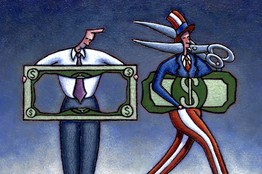'Taxmaggedon' Is a Real Threat
Next year's scheduled increases on dividends and capital gains will retard investment and derail the recovery.
By John SNow
WSJ.com
Nine years ago this month Congress passed President George W. Bush's Jobs and Growth Tax Relief Reconciliation Act. That bill's lower rates on capital, as well as the continuity in tax policy it established, have helped make our economy far more resilient.
The legislation's centerpiece was a reduction in the taxation of dividends and capital gains to 15%. Unfortunately, the 2003 tax rates, including those on capital income, are due to expire at the end of the year.
Capital warrants special tax treatment because of the central role it plays in generating economic growth and jobs. Capital is the very lifeblood of the market economy, the mainstay of innovation, and the foundation for future prosperity. As more of it is put to work today, labor output and wages will rise tomorrow. An appreciation of that critical relationship should guide how the tax system treats earnings from capital.
The double taxation of dividends—with corporate earnings first taxed 35% at the corporate level and then, when paid out to shareholders, taxed again—has been a long-standing and well-recognized distortion in the tax code. It favors debt financing over equity capital formation, because interest is deducted as a cost of doing business and lowers taxable income, while dividends are taxed twice.
The preference for debt financing and leverage shortchanges shareholders and is not healthy for corporate decision-making. Double taxation penalizes dividend payments and discourages managements from making them.
Congress did not eliminate the double taxation of dividends in 2003, but it substantially ameliorated the distortion. Dividends are now taxed at 15%, rather than the typically higher income-tax rates paid by shareholders. Importantly, the 15% tax rate was applied to capital gains as well. Capital gains previously had been taxed at 20% with special rates for assets held five years or longer. This symmetry between dividends and capital gains harmonized and simplified the regime for the taxation of capital and still stands today as a key achievement in modern tax policy.
Corporations responded to the lower rates on dividends by paying out more of their profits, which raises the returns to those holding stock and thus increases equity prices. Both trends strengthen Americans' retirement savings. As recent actions by Google, Apple and scores of other companies attest, corporations today find it more difficult to sit on cash instead of rewarding shareholders with dividend payouts.
With the expiration of the 2003 tax law at the end of this year, taxes—not only on capital earnings but also on ordinary incomes—will return to the much higher levels that previously existed.
This would be devastating to the fragile economic recovery, and to every American still looking for work. Combined with the expiration of temporary payroll tax relief, the United States faces what has now been labeled "taxmageddon"—a fiscal headwind so strong that it threatens a swift return to recession.
What seems to be lacking is a clear path to the future. Here are some suggestions for policy makers.
First, remember the principle that you always get less of anything you tax. For this reason, society discourages undesirable activities by imposing so-called "sin" taxes. By the same token, high marginal tax rates discourage work, risk-taking and capital formation.
Second, tax rates should be held as low as possible, consistent with maintaining fiscal balance. Low tax rates are not in conflict with fiscal sanity if the rate of government spending as a fraction of gross domestic product is reduced, or if the tax base is broadened with more fundamental tax reforms. It is encouraging to see so much interest gathering in support of changes to the tax code that would scrap many special tax breaks in favor of deeply lower marginal tax rates.
Third, marginal tax rates should be as neutral as possible across different types of economic activities. Otherwise the tax code distorts behavior in ways that sap economic strength, as market participants rely less on market price signals and more on government commands to decide how economic resources are used. Social engineering through the tax code comes at a very high cost.
Finally, policy makers should remember to "do no harm." A reversion to the kind of drastically higher marginal tax rates that existed in the past would be bad enough. It would only add insult to injury to use the economic crisis as an excuse to raise the tax burden on capital formation and thus reduce the lifeblood of America's job creators.
Unfortunately, we face that real prospect, as prominent proposals by the administration would triple the top dividend tax rate to nearly 45%, while doubling the top rate on capital gains to 30%. If one intended to cripple job creation, depress stock prices, and lower the value of retirement savings for working Americans, these proposals would be just what we should choose.
As taxmageddon looms, let's hope we choose
wisely.
Mr. Snow was secretary of the Treasury from 2003-2006.
A version of this article appeared May 14, 2012, on page A15 in some U.S. editions of The Wall Street Journal, with the headline: 'Taxmaggedon' Is a Real Threat.


